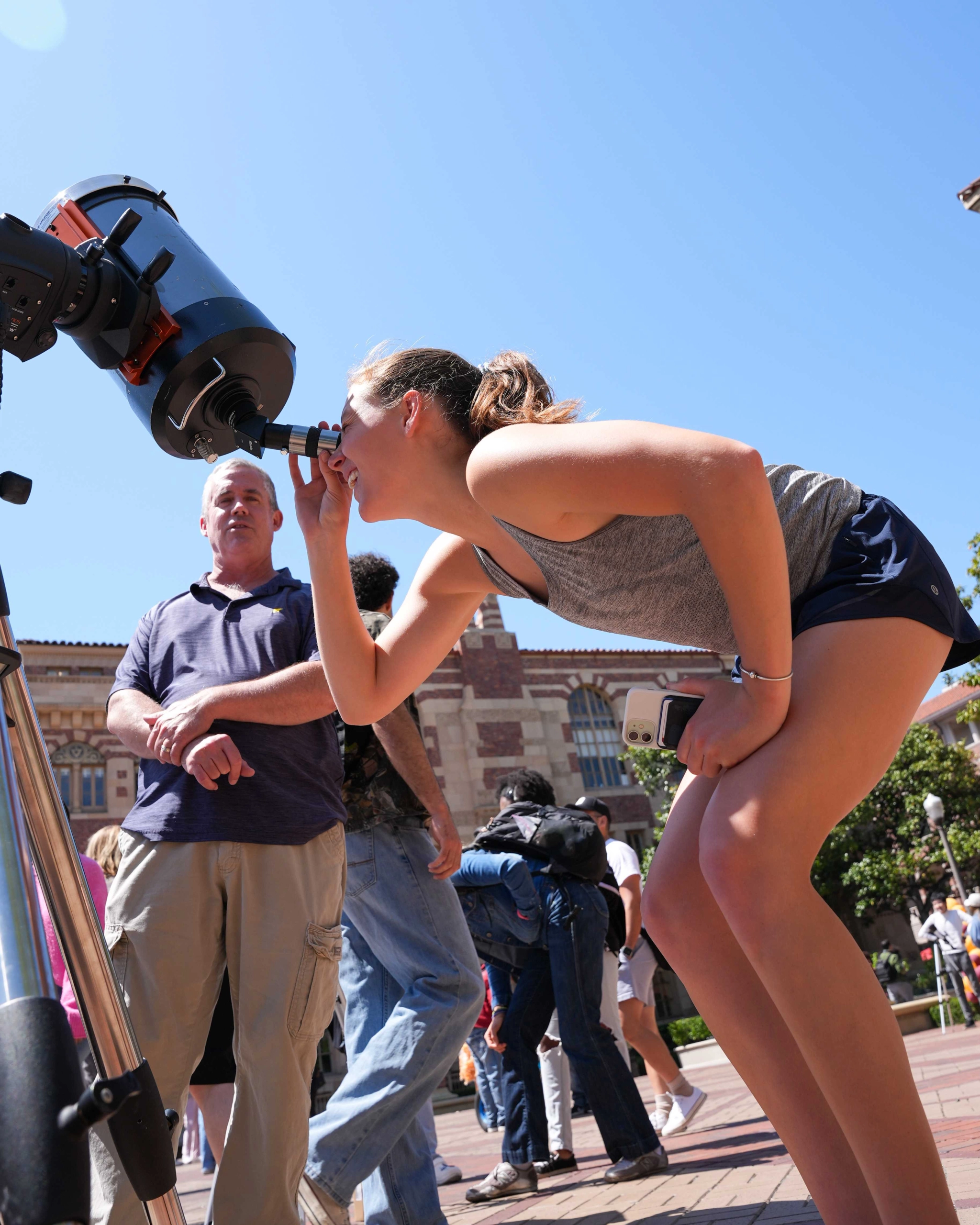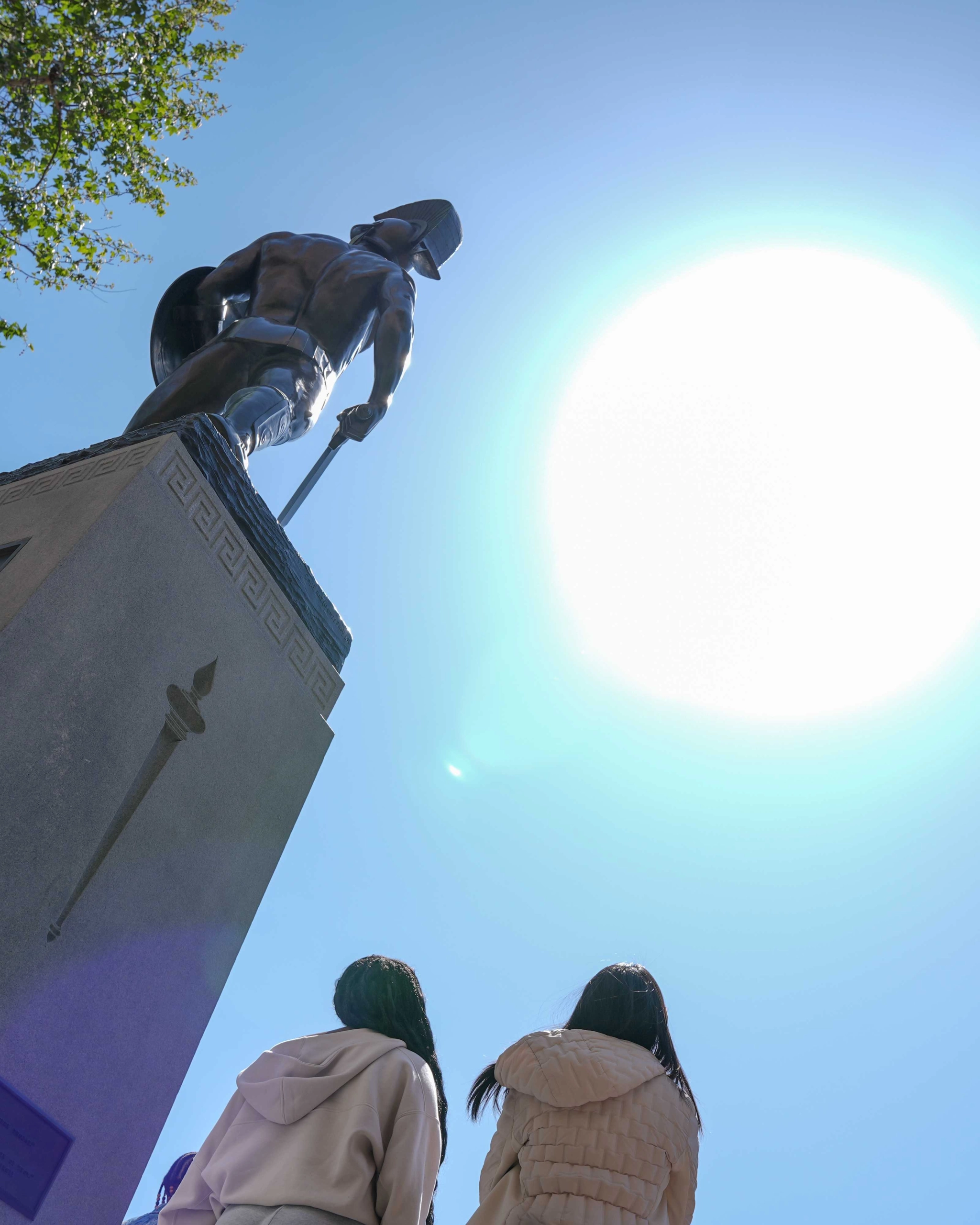Space excitement eclipses campus
The USC community gathered Monday morning to view the solar eclipse with special glasses and professional telescopes.
Eclipse glasses swapped hands, from student to student, at Tommy Trojan on Monday morning as roughly 300 attendees excitedly prepared to witness the first total solar eclipse to cross the contiguous United States since 2017.
While California didn’t experience the phenomenon of totality, the USC community came out to see the moon shrouding about half of the sun’s area to form a bright crescent in the sky, too dangerous to view with the naked eye.
The eclipse was clear in the sky starting around 10:39 a.m. and peaking at 11:12 a.m. It disappeared by 12:22 p.m., according to the Griffith Observatory. From 10 in the morning to noon, classes were taken out to Tommy Trojan or up on campus parking structures to better view the event.
Vahe Peroomian, a professor of physics and astronomy, set up astronomy-viewing equipment at the center of campus for passersby to get a better glimpse of what he called a “very brief but very important event.”
“What we’re trying to do is raise awareness for a very rare astronomical event, to get people to look up and notice what’s going on in the sky, to maybe have them experience it closer up,” Peroomian said.

Peroomian had also brought out special eclipse glasses to hand out for necessary eye protection, which ran out more than an hour before the eclipse’s peak due tobecause of popular demand.
“I’m hoping that students will be able to share that passion we have for astronomy, at least briefly today,” Peroomian said.
Mowen Zhao, a sophomore majoring in astronomy, came out with the Society of Physics Students to help Peroomian set up telescopes for attendees to see the eclipse through professional lenses.
“Oh, my. It’s fun. I’m very stressed,” said Zhao, who saw the partial eclipse last October with his research group at the Mount Wilson Observatory. “It’s nice to go out and enjoy the sun — well, part of the sun.”
For Kristi Skane, a freshman majoring in astronomy, the eclipse was a must-see event.
“I’m literally so excited,” Skane said about a half- hour before the peak. “I emailed my professor to miss class for this.”
The next time the Lower 48 states of the U.S. will experience a total solar eclipse will be in August 2045 — more than 21 years from now.
This year’s eclipse was a widely publicized event that Skane had been looking forward to for months.
“Of course, I’ve been alive for some of them. I think I’ve seen a lunar eclipse before, but this is the first [solar eclipse] that I’ve actually waited for and anticipated, and I’m actually sitting out here and watching it,” Skane said.

Another attendee, Kaley Chong, loved space as a kid. Chong, a junior majoring in computer science and business administration, grew up near NASA’s Ames Research Center, where she saw Saturn and Mars through telescopes. When she heard about Monday’s viewing event at Tommy Trojan, she knew she had to go.
“There’s resources for me to see, like they’re handing out glasses, so why not?” said Chong, who took and enjoyed Peroomian’s “The Universe” class to fulfill her General Education requirement.
In line to take a look through the professional telescope near Tommy Trojan, Emily Birdwell, a sophomore majoring in astronautical engineering, was passionately explaining the significance of Monday’s eclipse to her friends. Birdwell, who saw 2017’s solar eclipse in totality from her home state of Oregon, said it was a “really special moment.”
“I feel like it’s very human that we all come together to look at stupid silly things like this,” Birdwell said. “It makes you kind of humbled because you realize that you’re in the presence of these giant celestial bodies.”
We are the only independent newspaper here at USC, run at every level by students. That means we aren’t tied down by any other interests but those of readers like you: the students, faculty, staff and South Central residents that together make up the USC community.
Independence is a double-edged sword: We have a unique lens into the University’s actions and policies, and can hold powerful figures accountable when others cannot. But that also means our budget is severely limited. We’re already spread thin as we compensate the writers, photographers, artists, designers and editors whose incredible work you see in our daily paper; as we work to revamp and expand our digital presence, we now have additional staff making podcasts, videos, webpages, our first ever magazine and social media content, who are at risk of being unable to receive the support they deserve.
We are therefore indebted to readers like you, who, by supporting us, help keep our paper daily (we are the only remaining college paper on the West Coast that prints every single weekday), independent, free and widely accessible.
Please consider supporting us. Even $1 goes a long way in supporting our work; if you are able, you can also support us with monthly, or even annual, donations. Thank you.
Click here to add your own text
This site uses cookies. By continuing to browse the site, you are agreeing to our use of cookies.
Accept settingsDo Not AcceptWe may request cookies to be set on your device. We use cookies to let us know when you visit our websites, how you interact with us, to enrich your user experience, and to customize your relationship with our website.
Click on the different category headings to find out more. You can also change some of your preferences. Note that blocking some types of cookies may impact your experience on our websites and the services we are able to offer.
These cookies are strictly necessary to provide you with services available through our website and to use some of its features.
Because these cookies are strictly necessary to deliver the website, refusing them will have impact how our site functions. You always can block or delete cookies by changing your browser settings and force blocking all cookies on this website. But this will always prompt you to accept/refuse cookies when revisiting our site.
We fully respect if you want to refuse cookies but to avoid asking you again and again kindly allow us to store a cookie for that. You are free to opt out any time or opt in for other cookies to get a better experience. If you refuse cookies we will remove all set cookies in our domain.
We provide you with a list of stored cookies on your computer in our domain so you can check what we stored. Due to security reasons we are not able to show or modify cookies from other domains. You can check these in your browser security settings.
These cookies collect information that is used either in aggregate form to help us understand how our website is being used or how effective our marketing campaigns are, or to help us customize our website and application for you in order to enhance your experience.
If you do not want that we track your visit to our site you can disable tracking in your browser here:
We also use different external services like Google Webfonts, Google Maps, and external Video providers. Since these providers may collect personal data like your IP address we allow you to block them here. Please be aware that this might heavily reduce the functionality and appearance of our site. Changes will take effect once you reload the page.
Google Webfont Settings:
Google Map Settings:
Google reCaptcha Settings:
Vimeo and Youtube video embeds:
The following cookies are also needed - You can choose if you want to allow them: